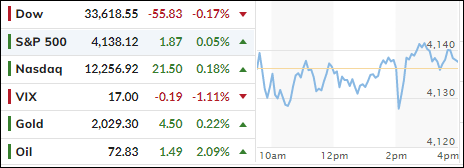
- Moving the markets
Traders found no motivation to drive the market in either direction, as the release of key inflation data cast a broad shadow on activity. On deck first will be April’s Consumer Price Index (PPI) on Wednesday, which is followed by the Producer Price Index (PPI) on Thursday.
Volatility was the name of the game last week, with the Dow and S&P notching their worst weekly advances since March, despite a strong rebound on Friday. Continuing discussions about whether the banking crisis has finally run its course—it hasn’t—kept traders somewhat agitated.
However, some encouragement pulled the Regional Banking Index (KRE) out of the doldrums early on, but that turned into a head fake, with the index tanking late in the session. Even the most recent banking cockroach, namely PACW, followed suit by rallying some 30%, but in the end, it surrendered all its early gains.
More whispering about short-selling on banks hit a brick wall, when none other than the Fed elaborated on the effectiveness of such a move:
The 2008 ban on short sales failed to slow the decline in the price of financial stocks;
…in fact, prices fell markedly over the two weeks in which the ban was in effect and stabilized once it was lifted.
A tip of the hat to ZeroHedge for this “finding.”
The most shorted stocks went into an early tailspin and only managed to squeeze back to the unchanged line, meaning a zero effect on market direction.
Bond yields rose with the 2-year kissing its 4% level but closing below it. The US Dollar dumped and pumped and managed to eke out a moderate gain. Surprisingly Gold followed suit and pushed towards its $2,030 marker.
I expect more of the same tomorrow in anticipation of the mid-week inflation data.
2. “Buy” Cycle Suggestions
For the current Buy cycle, which started on 12/1/2022, I suggested you reference my then current StatSheet for ETF selections. However, if you came on board later, you may want to look at the most recent version, which is published and posted every Thursday at 6:30 pm PST.
I also recommend you consider your risk tolerance when making your selections by dropping down more towards the middle of the M-Index rankings, should you tend to be more risk adverse. Likewise, a partial initial exposure to the markets, say 33% to start with, will reduce your risk in case of a sudden directional turnaround.
We are living in times of great uncertainty, with economic fundamentals steadily deteriorating, which will eventually affect earnings negatively and, by association, stock prices.
In my advisor’s practice, we are therefore looking for limited exposure in value, some growth and dividend ETFs. Of course, gold has been a core holding for a long time.
With all investments, I recommend the use of a trailing sell stop in the range of 8-12% to limit your downside risk.
3. Trend Tracking Indexes (TTIs)
Due to nervousness about the upcoming inflation figures (CPI/PPI), the markets trod water and went nowhere. As a result, our TTI’s barely changed.
This is how we closed 05/08/2023:
Domestic TTI: +0.50% above its M/A (prior close +0.68%)—Buy signal effective 12/1/2022.
International TTI: +6.62% above its M/A (prior close +6.33%)—Buy signal effective 12/1/2022.
All linked charts above are courtesy of Bloomberg via ZeroHedge.
Contact Ulli